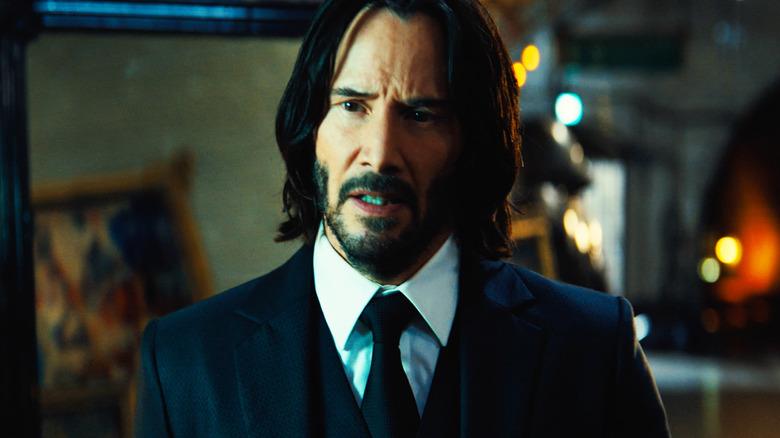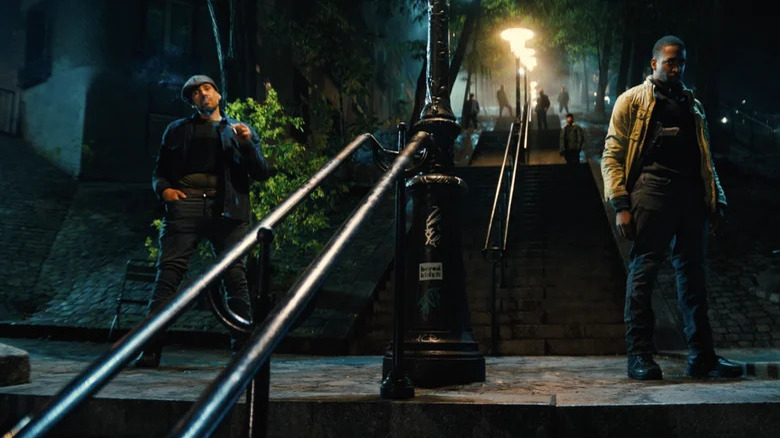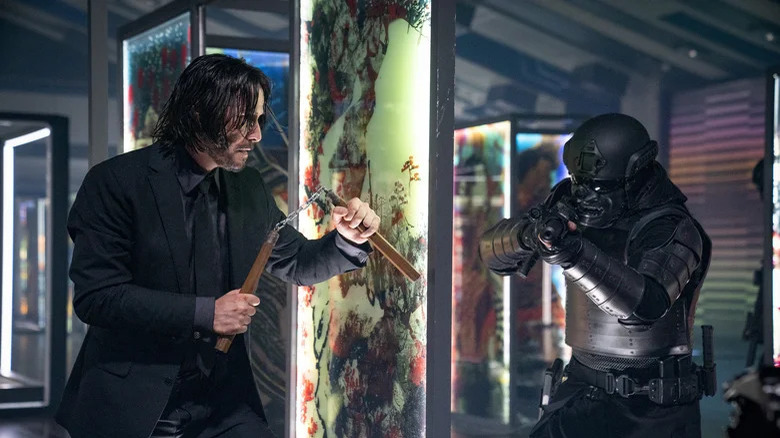John Wick's Long Fight Scenes Are Actually Intended To Make Fun Of The Action Genre
With the latest entry in the "John Wick" franchise, director Chad Stahelski pushed himself and his team beyond anything they'd done before. "John Wick: Chapter 4" is three hours long and packed with more elaborate action than any of the previous three entries in the saga — which is saying something.
This latest entry seemingly lurched from one set-piece to another, providing ever more inventive ways to punish its protagonist and showcase some stylish combat in the process. There was the infamous back-breaking staircase scene in Paris, which saw John Wick battle his way to the top of a staircase leading to the Sacré-Cœr, only to fall all the way back down and have to start over. That followed another memorable set-piece that involved John Wick fighting waves of attackers amidst speeding traffic at the Arc de Triomphe — an outlandish scene that even prompted Keanu Reeves to wonder if they went too far with the car stunts.
But going too far is the name of the game. People come to John Wick for its bombastic, over-the-top action, and this latest installment certainly provides it. In fact, in its efforts to push action choreography beyond where it's previously gone, you might say the franchise has taken action as an art form to deadly serious levels. But if you ask Stahelski himself, it's also all a bit of a joke.
'The whole gag is excess'
Speaking to RogerEbert.com, Stahelski elaborated on his conversations with Lionsgate about the film's epic runtime, explaining that he didn't have to fight "about the runtime" but rather justify, "why the runtime." As the director sees it, making such a long movie is only justifiable if you're able to keep an audience engaged throughout, and depending on who you ask, he and his team may or may not have achieved that with their latest effort. In fact, /Film's own Witney Seibold argues that "John Wick: Chapter 4" is proof that action movies can have too much action.
But Stahelski saved his most interesting comments for last. The filmmaker said:
"The whole gag of the movie is to have longer than long fight scenes—we're making fun of ourselves. We're making fun of the genre. We don't want to take them too seriously, we're trying to make this fun. The whole gag is excess. That's the whole moral of the story, the theme of this John Wick mythology."
Sure, there's always been a slight tongue-in-cheek aspect to the "John Wick" movies. They are, as Stahelski says, an exercise in excess. But there's something odd about Stahelski's comments here, in that it's never seemed as though the "John Wick" films are explicitly making fun of the action genre. Quite the opposite, in fact.
The John Wick films are serious about action
Chad Stahelski, Keanu Reeves, and his stunt coordinators have taken the action in their films seriously enough to spend time crafting their own gun-fu combat style, drawing from legends of the genre such as director John Woo and treating action itself with reverence and respect. Their style has influenced almost every other action movie released in recent years, and feels less like the result of a group of people "making fun of the genre" and more like the result of people taking it seriously enough to forgo character development and story in favor of putting action front and center.
If anything, the John Wick franchise stands as an argument for non-stop action being enough to carry a film. Stahelski, himself a former stunt performer and choreographer who doubled for Reeves in the "Matrix" movies, basically crafted a four-movie love letter to action itself. That's why I don't entirely buy that the whole thing was just an exercise in making fun of the action genre.
That said, there is an obvious absurdity to the whole franchise. After shooting wrapped on "John Wick: Chapter 4," Keanu Reeves gifted the stuntmen t-shirts tallying how many times they had each individually been dispatched by John Wick. And over the course of four films, Wick has racked up 439 kills, which is an insane body count when you consider these movies are supposed to take place over the course of just six months. In that sense, it feels more like Stahelski and co. are at times having fun with the genre rather than making fun of it.


